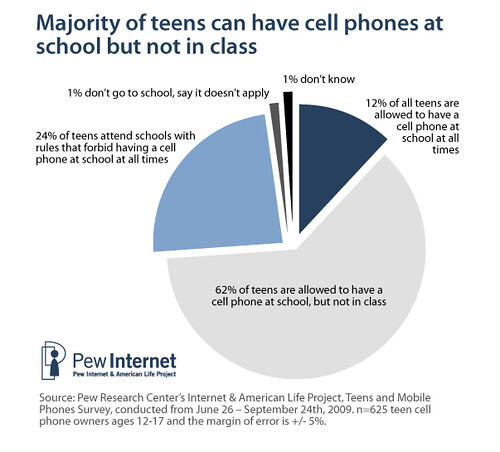
At my school, if we see a cell phone, we are supposed to take it away. Then, we give it to the principal, who has to call the parents come in for it. I have to admit, I have never taken a cell phone or mobile device from a student, but I have had discussions with students about keeping it out of my view and do not use it during school.
Isn’t that odd? Here I am, trying to show a path into technology and composing for my students, and I don’t allow them to use the single most important piece of technology many of them carry around with them all day long.
The graph above comes from a report just out from the Pew Internet & Family Life Project (these folks needs a huge round of applause for their work in making data available) around teens and their cell phones, particularly around text messaging.
Some of the findings in the report, which is entitled Teens and Mobile Phones:
- Half of teens send 50 or more text messages a day, or 1,500 texts a month, and one in three send more than 100 texts a day, or more than 3,000 texts a month.
- 15% of teens who are texters send more than 200 texts a day, or more than 6,000 texts a month.
- Boys typically send and receive 30 texts a day; girls typically send and receive 80 messages per day.
- Teen texters ages 12-13 typically send and receive 20 texts a day.
- 14-17 year-old texters typically send and receive 60 text messages a day.
- Older girls who text are the most active, with 14-17 year-old girls typically sending 100 or more messages a day or more than 3,000 texts a month.
- However, while many teens are avid texters, a substantial minority are not. One-fifth of teen texters (22%) send and receive just 1-10 texts a day or 30-300 a month.
But I am fascinated by how schools are dealing with cell phones and mobile devices. Most, like mine, have antiquated notions of the “disruptions” that can be caused by the devices. Few see the mobile devices as possible tools for learning.
And that has included me, to some degree. I don’t have much experience with cell phones (mine is an old version that barely functions as a phone) but I know there is something there “there” that we should figure out. I realize there are impediments — different phones have different services and Apps; the equity and access issues; parental permissions; and more.
Still, when we think about young people writing, the cell phone has certainly become a natural slate for ideas. How do we tap that?
Peace (in the Pew),
Kevin
Pingback: ODLA 2010: Technology Trends « Moving at the Speed of Creativity